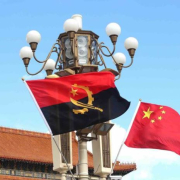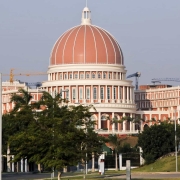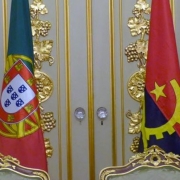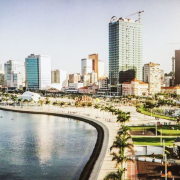The current economic situation in China and Angola

China’s economic crisis: facts and causes
There is a problem in the Chinese economy that appears to be structural and could affect relations with debtor countries such as Angola. Various factors are contributing to a decline in economic growth in China and an increase in unemployment, especially among young people, which could also imply some political instability within China itself.
Let’s start with some recent figures[1] :
-The July credit data released on 11 August showed a drop in demand for loans from companies.
-Retail sales rose by just 2.5 per cent in July compared to the previous year, below expectations of a 4.5 per cent increase.
-Industrial production only rose by 3.7 per cent in July compared to the previous year, below the 4.4 per cent increase that analysts were expecting.
The truth is that recent statistics published by China have caused severe concern. In addition to the aforementioned statistics, consumer prices in July were lower than a year ago, suggesting that we may be on the verge of deflation, which reflects a chronic shortage of demand in the economy. China’s foreign trade in the same month of July showed a sharp drop in exports due to weak global demand, accompanied by a sharper decline in imports, signifying the aforementioned weakness in domestic demand. Chinese companies and families are “shrinking”[2] . The seriousness of the situation led China’s leaders at a Politburo meeting last month to refer to this year’s economic recovery as “torture[3] .”
This poor performance raises several thoughts. The first is that we shouldn’t exaggerate. Just as there was an exaggeration in previous announcements about China as an economic superpower, when its GDP per capita will not exceed 13,000 USD in 2021,[4] while the GDP per capita in the United States is more than 70,000 USD, or even 25,000 USD in Portugal, the opposite exaggeration should not be made either, that China has entered an insurmountable abyss. What is clear is that the Chinese economy is in a moment of correction, as is the case with all economies, possibly requiring profound reforms and political adjustments.
Therefore, the context we have adopted in this work is to consider a crisis in the Chinese economy, but to believe that the right policy choices can overcome this crisis.
At this very moment, hopes of a Chinese recovery from the pandemic have faded, as consumption has generally been very subdued, especially for expensive items such as cars and houses, and private investment, the backbone of China’s economy, fell in the first half of this year for the first time since such data was published. Private companies and entrepreneurs aren’t spending much on investment or hiring staff. Youth unemployment has reached 21 per cent. The annual graduation of 11 to 12 million students this summer will exacerbate an already difficult situation because of the problems of finding suitable work and also because the Chinese labour market has become one in which most jobs are low-paid, low-skilled or in the informal economy.
It seems wrong to attribute all this to the pandemic. Most of the threats to China’s economy were growing a few years ago. The fundamental problem is that China has generated, over the last decade or more, a mountain of bad debts, unprofitable and uncommercial infrastructure and real estate, empty flat blocks, underused transport facilities and overcapacity, for example in coal, steel, solar panels and electric vehicles. Productivity growth has stagnated and China can boast one of the highest levels of inequality in the world[5] .
Furthermore, under Xi Jinping, it developed a more intense, state-centred and controlling system of governance, both for political reasons and to deal with the effects of its ailing development model.
We wonder to what extent the political interventions to limit billionaires like Jack Ma[6] have been positive for the economic environment. Whilst it’s true that they have averted the Russian danger of oligarchic state domination and signalled to the general population that power is concerned about excesses, it’s also true that they have sent a chill down the entrepreneurial spirit necessary for a competitive economy. Everyone will be afraid of growing too much, of being too conspicuous and, ultimately, of innovating. Because innovation and excessive attention can have negative repercussions.
In a way, the “animal spirit” that Keynes spoke of as the engine of any healthy economy has been “tamed” in China and this may be the main problem of its economy, which is neither measurable nor solvable with technical measures.
Chinese reaction and other possible directions
For the time being, China has announced the suspension of the release of the official unemployment rate among China’s urban youth aged between 16 and 24, which reached a new all-time high of 21.3 per cent in June. The State Council published new guidelines for stepping up efforts to attract foreign investment. And the central bank lowered interest rates[7] .
None of these measures seem to have the strength to reverse the cycle of decline in the Chinese economy.
Many authors argue that a huge fiscal stimulus would be needed to energise the economy, which should not be translated into more debt, but into pure “printing” of money, which makes sense in a situation of deflation. A kind of “helicopters with money” flying over the cities and dropping it off.[8]
It is also possible that this crisis will force the Chinese president to revise his policy towards the large economic groups and the business community in general, opting, like Lenin a century ago, for a new liberalisation and flexibilisation, while also seeking to ease the tension that has been building up between China and the United States.
In fact, we believe that a good part of the solution to China’s current economic problems lies in politics rather than economics, and in both domestic and foreign policy. Probably the best way out of the crisis would be to reintroduce the more ambiguous and flexible system of Jiang Zemin’s time. Jiang Zemin, president of China from 1993 to 2003, is considered “the man who changed China”. Many Chinese who grew up in the 1990s remember Jiang Zemin for overseeing China’s entry into the World Trade Organisation, and also for allowing the film Titanic to be broadcast. During the Asian financial crisis, Jiang emphasised the importance of finance and financial security for China’s national security and the building of a modern economy. At the same time, this did not imply a lessening of the power of the Chinese Communist Party and its political control. Some authors point to his tarnished record in relation to human rights and freedom of expression. Zemin oversaw the repression of national dissidents, the banning of religious groups such as Falun Gong and the suppression of the press and the Internet, and also maintained an uncompromising stance on Taiwan[9] .
The advantage for Jiang Zemin’s China is that he was able to maintain a balance between liberating market forces and innovation, and the Communist Party’s control of China.
And our opinion is that a large part of the Chinese crisis is not the result of economic factors alone or above all, but of the loss of that balance point that needs to be recovered.
Obviously, this doesn’t just depend on the Chinese leadership, but also on a change in the external situation of quasi-confrontation between the United States and China.
It’s well known that since the time of Donald Trump there has been a shift in US foreign policy towards China. What seemed like “Trumpism” became a central US policy under Joe Biden and today the United States sees and treats China as a potential future enemy that must be contained. Naturally, this coincided with Xi Jinping’s nationalist assertion, which abandoned the previous external caution, and began to want a strong China in the world context and without complexes, wanting the country to be a post-hegemonic alternative to the United States. So on both sides we had a voluntary confrontational initiative.
The question that arises is whether it is possible to retract and create a new space for US-China collaboration, which will certainly increase China’s prosperity, or whether the course is definitely strategic confrontation? In this confrontation, China will tend to compartmentalise and close itself off, losing the capacity for innovation linked to entrepreneurship, which increases the chances of conflict (more or less direct war) and hinders any Chinese economic recovery.
Impacts in Angola
This is the real situation of the Chinese economy at the moment. As mentioned, the fundamental “brakes” on growth seem to be twofold: from an economic point of view, excessive debt, and from a political point of view, which seems more important to us for the medium and long term, the accentuation of the force of political power in the economy and society, and the political condemnation of entrepreneurship and innovation.
Faced with this scenario, Angola is confronted with advantages and disadvantages that act dynamically.
One advantage is Luanda’s rapprochement with the United States and its relations with China. Angola could be a bridge country for a reunion between the two powers, a kind of proving ground where both can co-operate, compete and survive for mutual benefit. However, it could also become a disadvantage for the same reason, with Angola becoming one of the areas of dispute between the two powers, both wanting to pull it into their sphere of influence. This would be another difficult balance for João Lourenço to maintain.
In economic terms, there will be a possible tendency for the Chinese authorities to become more inflexible in relation to foreign debts, and this may already be happening with Angola, or could happen in the future. This is the normal reaction of countries in a “squeeze.” There is therefore the danger of greater Chinese pressure in economic terms on Angola, which could jeopardise Angola’s once again perilous public finances.
The “tree of patacas” spirit that prevailed in China-Angola financial relations from 2002 onwards is definitely over and will not be recovered. China will behave towards Angola, in greater or lesser detail, like any other international creditor, and its pressure will increase as the Chinese domestic economic situation deteriorates. Another challenge for João Lourenço.
One advantage that Angola could offer China is the creation of a large labour market for its young graduates. Cooperation agreements could be made to put Chinese people in Angola to train Angolan staff and help implement policies in areas such as public administration, in which China has millennia of experience, or telecommunications and information technology.
The Chinese civil service system has provided stability for the Chinese empire for more than 2,000 years and has provided one of the main outlets for social mobility in Chinese society. Today, in the 1980s, it has made a successful transition from a centralised Marxist economy to a mixed economy with strong growth.
China has also become one of the largest telecoms markets in the world, with more than one billion Internet users and monthly revenues of more than 130 billion yuan from the telecoms sector. The country has undergone several waves of reforms over the last three decades to liberalise and privatise its telecommunications industry. It is the experience gained in this immensity that can be put at the service of Angolans.
In these terms, the current phase of China-Angola relations could partly leave physical capital behind and centre on human capital, showing that relations between countries can mature. Angola could provide an outlet for Chinese companies and their young people.
What we have to realise is that the relationship is entering a “mature” phase in which each country has its own interests to defend. China will no longer bring “rains of money”, but rational investments, and this is what Angola must count on and counter. In fact, in terms of future markets, investment opportunities and an escape from China’s problems, Angola has a lot to offer and can be the “bargaining chip” in various negotiations.
[1] https://www.cnbc.com/2023/08/14/china-economy-new-loans-fall-property-fears-low-consumer-sentiment-.html
[2] https://www.cnbc.com/2023/08/17/david-roche-chinas-economic-model-is-washed-up-on-the-beach.html
[3] https://www.theguardian.com/business/2023/aug/11/china-economic-problems-show-things-are-seriously-amiss
[4] https://www.ceicdata.com/pt/indicator/china/gdp-per-capita
[5] On the structural and long-term problems of the Chinese economy see Frank Dikotter, China after Mao – The rise of a superpower, 2023.
[6] https://www.forbes.com/sites/georgecalhoun/2021/06/07/the-sad-end-of-jack-ma-inc/
[7] https://www.nytimes.com/2023/08/15/business/china-economy-downturn-unemployment.html, https://www.bloomberg.com/news/features/2023-08-20/xi-jinping-is-running-china-s-economy-cold-on-purpose?in_source=embedded-checkout-banner,
[8] Rui Verde, Helicópteros com dinheiro, 2013
[9] https://www.cfr.org/blog/jiang-zemin-put-chinas-economic-opening-practice










